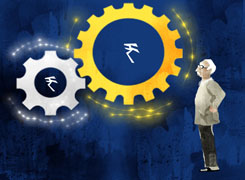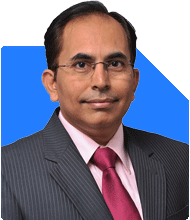Investment from loan - Is it a good idea?
Ramalingam Kalirajan |10902 Answers |Ask -Follow
Mutual Funds, Financial Planning Expert - Answered on Dec 16, 2024
He has an MBA in finance from the University of Madras and is a certified financial planner.
He is the director and chief financial planner at Holistic Investment, a Chennai-based firm that offers financial planning and wealth management advice.... more

Hello Ramalingam sir, In below communication, i see advice from one guru that investment from loan is not suggested under any circumstances, but i didn't understand good resoan behind. If i consider n compare investment made in MF (say HDFC mid Cap opportunity growth fund for instance) 5 yrs back from now vs interest on loan (say 10%) i see after equations (profit reinvestment/ compounding) n even after LTCG Tax deduction every year, i still would be drawing a good capital. Isnt it? Am i making any wrong calculation. Plz advice with figures.
Understanding the Appeal of Investing with Loaned Money
The logic behind the appeal is simple:
Borrow money at 10% interest.
Invest in a mutual fund delivering returns greater than 10%.
Use compounding to generate a profit.
For example, if the HDFC Mid Cap Opportunities Growth Fund delivered 18% annualised returns over the last 5 years, it seems to outperform the 10% loan interest rate, even after taxes.
But the calculation oversimplifies several critical aspects.
Why Investing with Borrowed Money Is Risky
1. Market Volatility Risks
Mutual fund returns fluctuate.
Past performance is not a guarantee of future returns.
A market downturn could cause your portfolio to underperform, leaving you with a loan to repay regardless of the market.
Example
If markets crash, the fund may return -10% in a year.
Your capital decreases, but loan EMIs remain fixed.
2. Guaranteed Loan Costs vs. Uncertain Returns
Loan interest is a fixed cost.
Investment returns are uncertain.
This mismatch increases the risk of financial loss.
Example with Figures
Loan Amount: Rs. 10 lakh at 10% annual interest.
Mutual Fund Return: 18% annualised over 5 years.
Loan Cost: Rs. 6.1 lakh in interest over 5 years (EMIs = Rs. 21,247/month).
If the market performs well:
Investment grows to Rs. 22.9 lakh (18% compounded over 5 years).
Profit after loan repayment: Rs. 6.8 lakh.
If the market underperforms (8% return instead of 18%):
Investment grows to Rs. 14.7 lakh.
Loan repayment leaves you with only Rs. 4.7 lakh, eroding your capital.
3. Stress on Cash Flow
Loan repayments (EMIs) are mandatory.
In emergencies or job loss, this can strain your cash flow.
4. Impact of Taxes
LTCG tax (12.5% beyond Rs. 1.25 lakh) and STCG tax (20%) reduce actual returns.
Loan interest has no tax benefit for investments.
Example of Tax Impact
Without taxes: Rs. 22.9 lakh after 5 years at 18%.
After LTCG tax: Rs. 21.4 lakh.
This reduces your profit further, diminishing the gap between returns and loan costs.
5. Risk of Leverage
Leverage amplifies both gains and losses.
In a worst-case scenario, you could lose your investment and still owe the loan.
Example of Loss
Rs. 10 lakh loan invested during a market downturn.
Portfolio falls 20% in Year 1 (value = Rs. 8 lakh).
You repay Rs. 21,247/month (total Rs. 2.55 lakh annually).
After 5 years, you could lose Rs. 4 lakh or more.
Comparing Scenarios: Borrowed vs. Own Money
Borrowing Money for Investment
Loan Amount: Rs. 10 lakh.
Returns: 18% compounded over 5 years.
Total Returns: Rs. 22.9 lakh.
Loan Repayment: Rs. 16.1 lakh (Principal + Interest).
Net Profit: Rs. 6.8 lakh.
Investing Own Money
Investment Amount: Rs. 10 lakh.
Returns: 18% compounded over 5 years.
Total Returns: Rs. 22.9 lakh.
No Loan Repayment: Entire profit remains yours.
The difference is clear: investing with your own money eliminates repayment stress, taxes, and risk.
Final Insights
Investing with borrowed money can backfire due to unpredictable markets and fixed loan costs.
Use your own funds for investments instead of leveraging loans.
Stay diversified and invest systematically for long-term wealth creation.
Best Regards,
K. Ramalingam, MBA, CFP,
Chief Financial Planner,
www.holisticinvestment.in
https://www.youtube.com/@HolisticInvestment
You may like to see similar questions and answers below
Omkeshwar Singh | Answer |Ask -Follow
Head, Rank MF - Answered on Nov 29, 2019
Ramalingam Kalirajan |10902 Answers |Ask -Follow
Mutual Funds, Financial Planning Expert - Answered on Jul 29, 2024
Ramalingam Kalirajan |10902 Answers |Ask -Follow
Mutual Funds, Financial Planning Expert - Answered on Sep 08, 2025
Anu Krishna |1749 Answers |Ask -Follow
Relationships Expert, Mind Coach - Answered on Dec 17, 2025
Anu Krishna |1749 Answers |Ask -Follow
Relationships Expert, Mind Coach - Answered on Dec 17, 2025
Radheshyam Zanwar |6748 Answers |Ask -Follow
MHT-CET, IIT-JEE, NEET-UG Expert - Answered on Dec 17, 2025
Anu Krishna |1749 Answers |Ask -Follow
Relationships Expert, Mind Coach - Answered on Dec 17, 2025
Dr Shakeeb Ahmed Khan |184 Answers |Ask -Follow
Physiotherapist - Answered on Dec 17, 2025
T S Khurana |538 Answers |Ask -Follow
Tax Expert - Answered on Dec 17, 2025
T S Khurana |538 Answers |Ask -Follow
Tax Expert - Answered on Dec 17, 2025
Janak Patel |72 Answers |Ask -Follow
MF, PF Expert - Answered on Dec 17, 2025
Ramalingam Kalirajan |10902 Answers |Ask -Follow
Mutual Funds, Financial Planning Expert - Answered on Dec 17, 2025
Samraat Jadhav |2511 Answers |Ask -Follow
Stock Market Expert - Answered on Dec 17, 2025



























